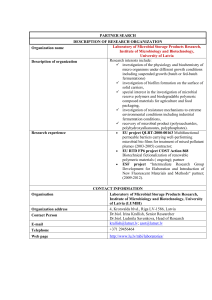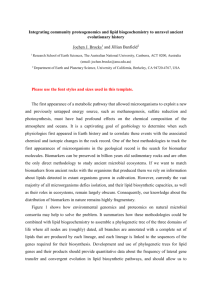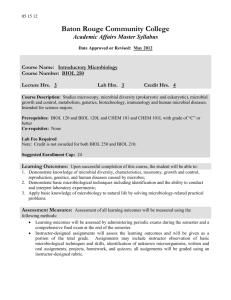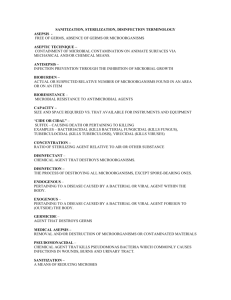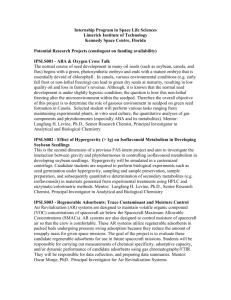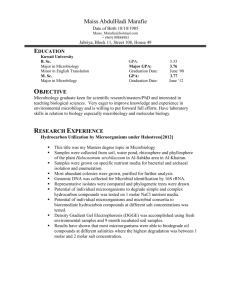Space Microbiology: An Overview
advertisement
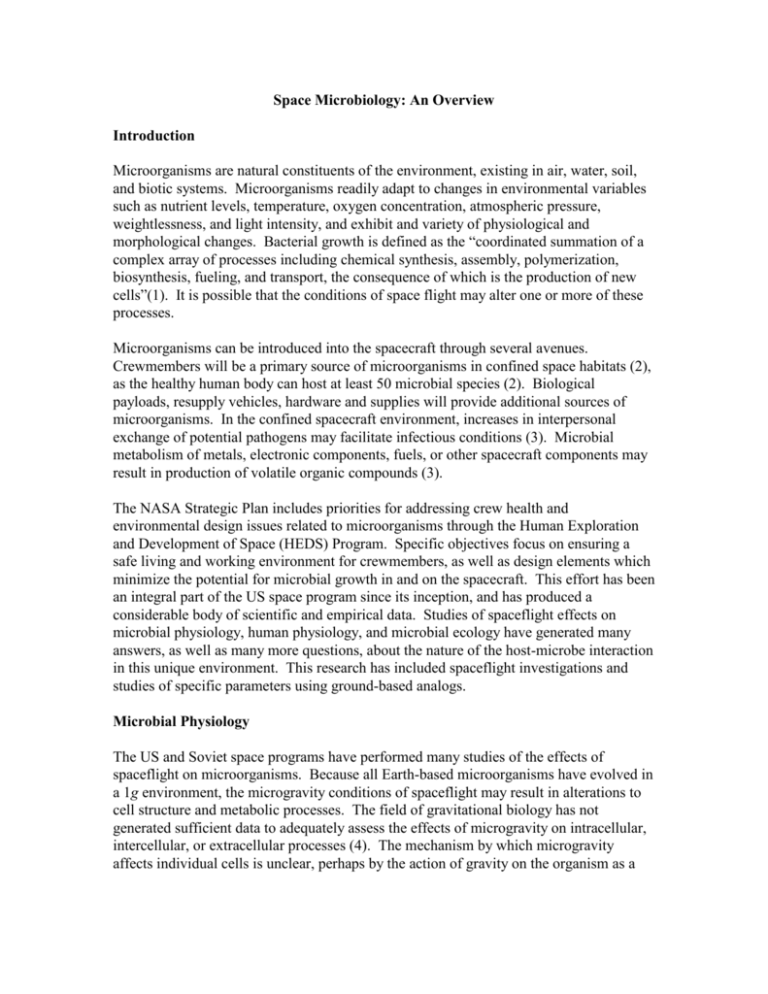
Space Microbiology: An Overview Introduction Microorganisms are natural constituents of the environment, existing in air, water, soil, and biotic systems. Microorganisms readily adapt to changes in environmental variables such as nutrient levels, temperature, oxygen concentration, atmospheric pressure, weightlessness, and light intensity, and exhibit and variety of physiological and morphological changes. Bacterial growth is defined as the “coordinated summation of a complex array of processes including chemical synthesis, assembly, polymerization, biosynthesis, fueling, and transport, the consequence of which is the production of new cells”(1). It is possible that the conditions of space flight may alter one or more of these processes. Microorganisms can be introduced into the spacecraft through several avenues. Crewmembers will be a primary source of microorganisms in confined space habitats (2), as the healthy human body can host at least 50 microbial species (2). Biological payloads, resupply vehicles, hardware and supplies will provide additional sources of microorganisms. In the confined spacecraft environment, increases in interpersonal exchange of potential pathogens may facilitate infectious conditions (3). Microbial metabolism of metals, electronic components, fuels, or other spacecraft components may result in production of volatile organic compounds (3). The NASA Strategic Plan includes priorities for addressing crew health and environmental design issues related to microorganisms through the Human Exploration and Development of Space (HEDS) Program. Specific objectives focus on ensuring a safe living and working environment for crewmembers, as well as design elements which minimize the potential for microbial growth in and on the spacecraft. This effort has been an integral part of the US space program since its inception, and has produced a considerable body of scientific and empirical data. Studies of spaceflight effects on microbial physiology, human physiology, and microbial ecology have generated many answers, as well as many more questions, about the nature of the host-microbe interaction in this unique environment. This research has included spaceflight investigations and studies of specific parameters using ground-based analogs. Microbial Physiology The US and Soviet space programs have performed many studies of the effects of spaceflight on microorganisms. Because all Earth-based microorganisms have evolved in a 1g environment, the microgravity conditions of spaceflight may result in alterations to cell structure and metabolic processes. The field of gravitational biology has not generated sufficient data to adequately assess the effects of microgravity on intracellular, intercellular, or extracellular processes (4). The mechanism by which microgravity affects individual cells is unclear, perhaps by the action of gravity on the organism as a whole or by direct action at the cellular level (4). Lack of a clear distinction may explain some of the different descriptions of these effects. Several studies of phage induction in bacteria during space flight have suggested an increase in phage activity (5,6,7,8,9,10). The differences in degree of phage induction among these studies may be attributed to differences in handling techniques, flight conditions, test parameters, and evaluation methods. The effects of spaceflight on microbial growth rates have also been studied. Although these studies have often produced conflicting results, a general tendency toward increased cell growth, biomass production, and growth rate has been observed (11,12,13,14). Other studies have suggested spaceflight induced changes in microbial physiology such as altered antibiotic resistance (15,16,17,18), changes in circadian rhythms (19), changes in metabolic processes (20), and genetic alterations (20). Human Physiology The effects of spaceflight on human physiology have been the subject of constant study since the first manned orbital flights. Development of better technology has resulted in significant increases in spaceflight duration, which result in more pronounced physiological effects in crewmembers. Effects on the cardiovascular, neurovestibular, musculoskeletal, endocrine, and hematological systems are well documented (21). Many changes in the human immune response have been observed (22, 23), which are of particular significance to the ongoing efforts to prevent infectious disease among crewmembers. Because crewmembers will be the primary source of microorganisms, the risk of infectious diseases may be affected by exchange of microbiota among crewmembers within the close quarters of the spacecraft. This exchange was first demonstrated during the Apollo program , when bacteriophage typing revealed that Staphylococcus aureus was transferred from one crewmember to another during a mission (24). Such transfer was subsequently demonstrated on additional Apollo flights (25, 26), Skylab missions (27, 28), and in the Apollo-Soyuz Test Project (29). These findings were further documented in the Space Shuttle program using molecular techniques which provided a much more sensitive means for strain typing. Transfer of Staphylococcus aureus and Candida albicans among crewmembers was demonstrated using very precise DNA fingerprinting techniques (30, 31). Further studies of the effects of spaceflight on infectious disease risk are part of the current effort to prepare for the future of manned space exploration. Microbial Ecology Understanding the behavior of microorganisms in closed environments is essential to development of systems for long duration manned spaceflight. Terrestrial systems having comparable properties have been extensively studied and used as a model for spaceflight systems. Several studies of microbial load aboard submarines have been conducted by the US Navy. In one study of bacterial sedimentation rates and microbial load in the air were examined. The sedimentation rate decreased during the study period, and there was no change in the microbial load between the control and test periods (32). The predominant microorganisms in the air during both periods were Micrococci and Streptococci. Clinical data on the submarine crew indicated that these organisms were carried by a significant number of subjects in the throat (32). This finding supports the longstanding assertion that crewmembers will be the major source of microbial loading in the spacecraft environment. In another study, Neisseria meningitidis was isolated from 26% of crewmembers and a 21% increase in resistance to the antibiotic sulfadiazine was observed during the patrol period (33). No resistant strains were isolated initially, and this drug was not administered during the patrol period. It was suggested that the closed environment and interactions among the crew promoted selection of resistant strains (34). A number of studies have also examined fungal growth aboard submarines (35). Although Penicillium, Aspergillus, and yeast species were recovered, their relative quantities changed significantly during the patrol period. Penicillium was initially the predominant organism, but was superseded by yeasts after two weeks at sea (35). Yeasts were most abundant on surfaces, while Penicillium predominated in the air samples. Despite the presence of these organisms, there was little evidence of infections or allergies among crewmembers (35). The Soviets have conducted many experiments using “airtight environments” to model spaceflight conditions. These studies have indicated changes in microbial populations including increases in antibiotic resistance (36) and shifts in relative quantities of commensal microbiota in human subjects (37). The presence of molds in these environments was consistently found despite extensive use of disinfectants (38). The microbial ecology of the spacecraft has also been extensively studied during the US manned spaceflight programs (39-43). The microbial populations in the spacecraft environment were well characterized during the Apollo mission series. In general, the numbers of aerobic microorganisms were found to increase, while the diversity of species and numbers of anaerobes decreased (40). Decreases in the numbers of fungal isolates were observed in the Apollo missions, as well as during the Skylab program (40). Although humans are the chief contributors to the microbial populations aboard spacecraft, there are other sources of microbial loading. During the assembly and testing associated with development of planetary testing requirements, it was reported that about 25 percent of the microorganisms found on the Viking lander capsules, orbiters, and shrouds were soil bacteria (44) The remaining 75 percent were classified as indigenous human microbiota. Some of these organisms survived even the terminal heat treatment of the spacecraft. The Explorer 33 spacecraft was found to have a microbial burden of 2.6 x 105 CFU at launch (45). Similarly, the Apollo 10 and 11 command modules were contaminated by 2.7 x 104 CFU per square foot (46). Approximately 95% of the organisms recovered in each case were indigenous human microbiota (47). Other sources of microorganisms in spacecraft include experimental animals and plants, supplies, foods, and water. Conclusion The presence of microorganisms and their potential effects has been a source of study since the advent of manned spaceflight. The unique aspects of the spaceflight environment, particularly the microgravity condition, have been shown to effect microbial and human physiology in many ways. Changes in microbial growth rates, survival, phage-induction, and antibiotic susceptibility have been observed. Effects of spaceflight on human physiology in such areas as cardiac, musculoskeletal, neurological, and immune function have been well documented. The unique microbial ecology of the spacecraft environment has also been the focus of many studies. Formation of an indigenous population within the closed environment of the spacecraft has been demonstrated. As we prepare for the longer duration spaceflights necessary to enter the era of manned planetary exploration, it is critical that we develop a better understanding of the changes that may be induced in the host-microbe relationship in the unique environment of spaceflight. Development of countermeasures to undesirable microbial interactions with the spacecraft and crewmembers is an important part of current research efforts. The study of microbial impacts on humans and spacecraft will continue to be a vital part of manned space exploration. References 1. Ingraham, J.L.; Maaloe, O.; Neidhardt, F.C. Growth of the Bacterial Cell. Sinauer Associated, Inc. Sudbury, MA, 1983. 2. Rodgers, E.B.; Seale, D.B.; Borass, M.E.; and Somer, C.V. Ecology of Microorganisms in a Small Closed System: Potential Benefits and Problems for Space Station. SAE Technical Paper Series No. 891491, 19th Intersociety Conference on Environmental Systems, San Diego, July 24-26, 1989. 3. Rodgers, E.B. Ecology of Microorganisms in a Small Closed System: Potential Benefits and Problems for Space Station. National Aeronautics and Space Administration, Technical Memorandum-86563, Washington, DC, 1987. 4. Todd, P. Gravity-Dependent Phenomena at the Scale of a Single Cell. American Society for Gravitational and Space Biology. 2:95-113, 1989. 5. Taylor, G.R. Space Microbiology. Ann Rev Microbiol 28:121-137, 1974. 6. Taylor, G.R. Cell Anomalies Associated with Spaceflight Conditions. Adv Exp Med Biol 225:259-271, 1987. 7. Mattoni, R.H.T.; Keller, E.C.; Ebersold, W.T.; Eiserling, F.A.; and Romig, W.R. Induction of Lysogenic Bacteria in the Space Environment. In: The Experiments of Biosatellite II. J. Saunders (Editor), National Aeronautics and Space Administration (SP-204). Washington, DC, pp.309-324, 1971. 8. Zhukov-Verezhnikov, N.N., et. al. Biological Effects of Space Flight on the Lysogenic Bacteria E. coli (K-12) and on Human Cells in Culture. Cosmic Res 9:267-273, 1971. 9. Alpatov, A.M.; Il’in, A.M.; Antipov, V.V.; Tairbekov, M.G. Biological Experiments on COSMOS-1887. Kosmicheskaya Biologiya I Aviakoshicheskaya Meditsina 25(5):26-32, 1988. 10. Parfenov, G.P.; Lukin, A.A. Results and Prospects of Microbiological Studies in Outer Space. Space Life Sci 4:160-179, 1973. 11. Menningmann, H.D.; Lange, M. Growth and Differentiation of Bacillus subtillus Under Microgravity. In: Proceedings of the Norderny Symposium on Scientific Results of the German Spacelab Mission D1. 27-29 August 1986. P.R. Sahm; R. Jansen; and M.H Keller (Editors), German Ministry of Research and Technology, Bonn, Germany pp. 398-402, 1987. 12. Gurovskiy, N.N. Results of Medical Research on the Orbital Scientific Research Complex Salyut-6-Soyuz; Chapter 15: Weightlessness and it’s Influence on Microorganisms and Plants. Izdatel’stvo “Nauka” Moscow, USSR. pp. 369-391, 1986. 13. Vaulina, E.N., et. al. Effect of Space Flight on Developing Organisms. Vliyaniye Kosmicheskogo Poleta na Razvivayushchiyesya Organizmy. Naukova Dumba Press, Kiev. pp.1-159, 1978. 14. Cogoli, A.; Cogoli, M.; Bechler, B.; Lofenzi, F.; Gmünder, F. Microgravity and Mammalian Cells. In: Microgravity as a Tool in Developmental Biology. T. Duc Guyenne (Editor), Proceedings of ESA Symposium during the 11th ISDB Congress, ESA (SP-1123), Paris, France. pp. 11-19, January 1990. 15. Taylor, G.R. Apollo 14 Microbial Analyses. National Aeronautics and Space Administration Technical Memorandum (NASA TM X-58094), Washington, DC, 1972. 16. Taylor, G.R. Medical Microbiological Analysis of U.S. Crewmembers. In: The Apollo-Soyuz Test Project Medical Report. Compiled by A.E. Nicogossian, M.D. Scientific and Technical Information Office, National Aeronautics and Space Administration (NASA SP-411), Washington, DC, pp. 69-81, 1977. 17. Il’in, V.K. Drug Resistance of E. Coli Isolated from Cosmonauts. Kosmicheskaya Biologiya I Aviakosmicheskaya Meditsina 23(4):90-91, 1989. 18. Lapchine, L., et. al. Antibacterial Activity of Antibiotics in Space Conditions. In: Proceedings of the Norderny Symposium on Scientific Results of the German Spacelab Mission D1. 27-29 August 1986. P.R. Sahm; R. Jansen; and M.H Keller (Editors), German Ministry of Research and Technology, Bonn, Germany pp. 395397, 1987. 19. Sulzman, F.M.; Ellman, D.; Fuller, C.A.; Moore-Ede, M.C.; Wassmer, G. Neurospora Circadian Rhythms in Space: A Reexamination of the EndogenousExogenous Question. Science 225: 232-234, 1984. 20. Cioletti, L.A.; Pierson, D.L.; Mishra, S.K. Microbial Growth and Physiology in Space: A Review. SAE Technical Paper Series No. 911512. 1991. 21. Nicogossian, A.E.; Huntoon, C.L.; Pool, S.L., eds. Space Physiology and Medicine, 3rd Edition. Philadelphia, PA: Lea & Ferbiger, 1994. 22. Konstantinova, I.V.; Rykova, M.P.; Lesnyak, A.T.; Antropova, E.A. Immune Changes During Long-Duration Missions. J Leukocyte Biol 54: 189-201, 1993. 23. Taylor, G.R. Immune Changes During Short-Duration Missions. J Leukocyte Biol 54: 202-208, 1993. 24. Taylor, G.R. Recovery of Medically Important Microorganisms from Apollo Astronauts. Aerospace Med 45:824-828, 1974. 25. Berry, C.A. Summary of Medical Experience in the Apollo 7 through 11 Manned Space Flights. Aerospace Med 41(5):500-519, 1970. 26. Fox, L. The ecology of microorganisms in a closed environment. In: Life Sciences and Space Research, Vol. 9. Vishniac, W. (Editor) Berlin: Academie-Verlag, pp. 69-74, 1971. 27. Johnston, R.S.; Dietlein, L.F., eds. Biomedical Results from Skylab (NASA SP-377). Washington, DC: US Government Printing Office, 1977. 28. Taylor GR, Graves RC, Brockett RM, Ferguson JK, Mieszkuc BJ. 1977. Skylab Environmental and Crew Microbiology Studies. In Biomedical Results from Skylab. Johnston RS, Dietlein, LF, eds. Scientific and Technical Information Office, National Aeronautics and Space Administration. 53-63. 29. Taylor GR, Kropp KD, Henney MR, Ekblad SS, Baky AA, Groves TO, Molina TC, Decelle JG, Carmichael CF, Gehring NJ, Young EL, Shannon IL, Frome WJ, Funderburk NR. 1977. Microbial Exchange: Experiment AR-002. In Apollo-Soyuz Test Project: Summary Science Report Vol. I. Scientific and Technical Information Office, National Aeronautics and Space Administration. 237-255. 30. Pierson, D.L., Chidambarum, M., Heath, J.D., Mallary, L., Mishra, S.K., Sharma, B., and Weinstock, G.M. 1996. Epidemiology of Staphylococcus aureus in the Space Shuttle. FEMS Immunology & Medical Microbiology 16: 273–281. 31. Pierson, D.L., Mehta, S.K., Magee, B.B., and Mishra, S.K. 1995. Person-to-person transfer of Candida albicans in the spacecraft environment. Journal of Medical and Veterinary Mycology 33: 145–150. 32. Boyden, D.G. The Bacterial Flora in Fleet Ballistic Missile Submarines during Prolonged Submergence. US Naval Submarine Medical Center Report No. 386, 1962. 33. Marsden, P.H.; Fallon, R.J.; Larsen, R.T. Microbiological Studies in Submarines: Ecology of Meningococci in Symptomless Carriers. Journal of the Royal Naval Medical Service 60:137-142, 1974. 34. Reit, R.J.; Smith, M.D. A Longitudinal Study of Neisseria meningitidis Carriers in Submarine Crews. Submarine Medical Research Laboratory, US Naval Submarine Medical Center Report No. 532, 1968. 35. Milroy, W.C. The Fungal Flora of the Submarine Environment During Prolonged Submergence. Submarine Medical Research Laboratory, US Naval Submarine Medical Center Report No. 535, 1968. 36. Polikarpov, N.A.; Bragina, M.P. Sensitivity to Antibiotics of Opportunistic Human Indigenous Microorganisms Before and After Isolation in an Airtight Environment. Kosmicheskaya Biologiyai Aviakosmicheskaya Meditsina 23(3):62-65, 1989. 37. Zaloguyev, S.N.; Utkina, T.G.; Shinkareva, M.M. The Microflora of the Human Integument During Prolonged Confinement. Life Sci Space Res 9:55-59, 1971. 38. Deshevaya, Ye.A.; Novikova, A. Characteristics of the Formation of Microflora in Hermetically Sealed Living Quarters with Altered Composition of the Atmosphere. Kosmicheskaya Biologiya i Aviakosmicheskaya Meditsina: Tezisy dokladov VIII Vsesoynznoy Konferentsii, Kaluga, [Space Biology and Aerospace Medicine: Abstracts of Papers Delivered at the Eight All-Union Conference] O.G. Gezenko (editor), Moscow: Nauka, 25-27 June 1986. 39. Curtis, A.C. Space Almanac. Arcsoft Publishers, Woodsboro, MD, 1990. 40. Tairbekov, M.G.; Parfyonov, G.P. Cellular Aspects of Gravitational Biology. Physiologist 24(6): 69-72, 1981. 41. Babskiy, V.G. On the Role of Mass Transfer in the Growth of Microorganisms in Weightlessness. In: Kosmicheskaya Biologiya iAviakosmicheskaya Meditsina: Sbornik Nauchnykh Trudov [Space Biology and Biotechnology: A Collection of Scientific Papers] L.M. Synik (Editor), Naukov Dumka Press, Kiev, pp. 10-18, 1986. 42. Todd, P. Gravity-Dependent Phenomena at the Scale of the Single Cell. American Society for Gravitational & Space Biology 2:95-113, 1989. 43. Taylor, G.R. Space Microbiology. Ann Rev Microbiol 28:121-137, 1974. 44. Taylor, G.R. Cell Anomalies Associated with Spaceflight Conditions. Adv Exp Med Biol 225:259-271, 1987. 45. Vaulina, E.N., et. al. Effect of Spaceflight on Developing Organisms. Vliyaniye Kosmicheskoto Poleta na Razvivayushchiyesya Organizmy. Naukova Dumba Press, Kiev, pp. 1-159, 1978. 46. Manko, V.G., et. al. Changes Over Time in Proteus vularis Cultures Grown in the ROST-4M2 Device on the Salyut-7 Space Station. In: Kosmicheskaya biologiya I Aviakosmicheskaya Meditsina: Sbornik Nauchnykh Trukov [Space Biology and Biotechnology: A Collection of Scientific Papers] L.M. Synik (Editor), Naukov Dumka Press, Kiev, pp. 3-10, 1986. 47. Zharikova, G.G.; Rubin, A.B.; and Nemchinov, A.V. Effects of Weighlessness, Space Orientation, and Light on Geotropism and the Formation of Fruit Bodies in Higher Fungi. Life Sci Space Res 15:291-294, 1977.


